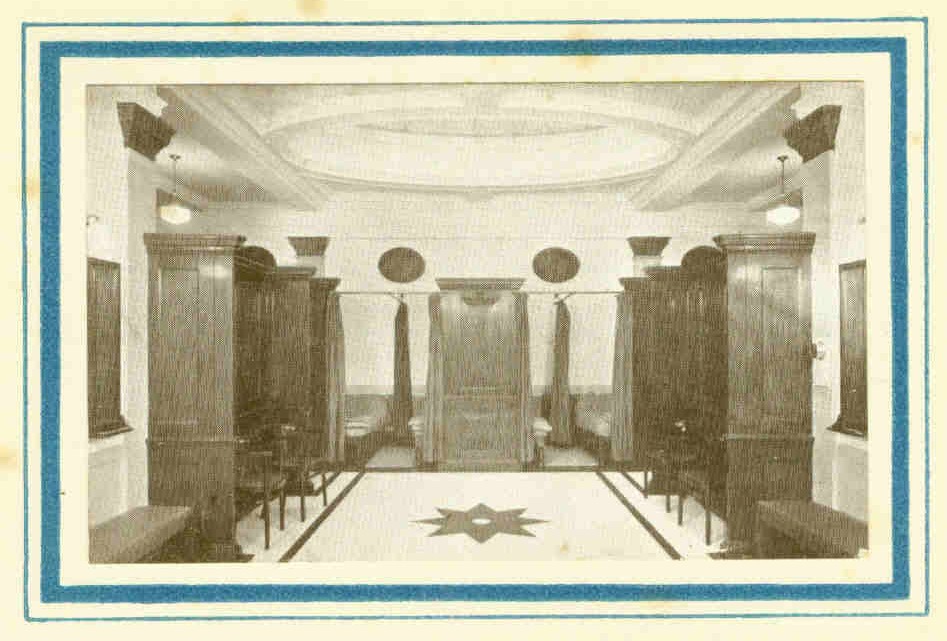Victorian Turkish Baths Picture of the Month for APRIL 2013
Newcastle-on-Tyne: Northumberland Road: City Pool:
Turkish baths cooling-room, 1928

The first Turkish baths opened on this site in 1859. They were, therefore, one of the earliest to open to the English public, one year before the first London baths were opened. They remained open till some time around 1926.
The new baths were opened in 1928 and guests were presented with an illustrated commemorative booklet from which the following description is excerpted.
The [building's] interior marks a distinctive advance on the standards of finish demanded by the public, and although no charge of extravagance or undue luxury could be maintained, the principle of insisting on sound and efficient materials, methods and equipment has been adhered to with tenacity.
The Turkish suite, though of necessity limited in capacity, is a model. Instead of being a basement accident, the usual fate of Turkish baths in this country, the suite is designed and each apartment is a well-proportioned and finished chamber…
The Cooling Room with attendant's room and toilets has 10 double cubicles. The shampoo has four slabs and there are three hot rooms and a Russian vapour room. The equipment and heating is unique in this country, and is the result of Major Austen's (of Messrs Young, Austen & Young) wide knowledge of American practice.
The Turkish Bath equipment is unique in this country. It has been the general practice in the past to introduce air at a high temperature in the Laconicum, and from here to pass it into the Calidarium, and thence to the Tepidarium, the temperature gradually dropping en route; the same air being re-used in each of the Hot rooms.
At Northumberland Road the fresh air supply for the Turkish Baths is taken from some 30 feet from the ground level and is then passed through a water spray chamber, where it is thoroughly cleansed of all impurities. It then passes to the Battery Chamber. Each of the Hot Rooms has its own Heater Battery and the air after passing through these is taken direct to its respective room. The temperature of the air leaving each battery is automatically controlled by the temperature in the Hot Rooms. Each room therefore receives a direct supply of fresh and warmed air at the required temperature and the vitiated air is taken away in ducts and delivered to the atmosphere. This design is so vastly superior, both in hygiene and ease of control, that it will undoubtedly be followed in future Turkish Bath equipments in this country. A further interesting section of the Engineering Plants is the warming and ventilation of the Concert Hall. A total of 2,000,000 cubic feet of air is washed, de-humidified, warmed and delivered into the hall every hour.
The positions of the air inlets and extracts were arranged after very careful study to ensure air distribution without draughts and to maintain a fresh and vitalizing atmosphere in all parts of the Hall. 3
In fact though the standard was higher than many baths of the time, the idea of feeding fresh air directly to each room instead of passing through the rooms in turn had already been adopted as early as 1909 in the baths at the RAC Club. Nevertheless, the baths were praised in the architectural press generally, as this excerpt from the Architect and Building News shows.
On the whole, [the architects], Messrs Nicholas & Dixon-Spain, have mastered their problem well. The corridor shape of their first hot room, laid [out] in bays, is the key to the design. They have placed the vapour bath in a side track off the main circulation, which is where it should be, since its use is optional. Less satisfactory, but probably unavoidable, are the shapes and connection of the two hottest rooms. The massage room is divided by a centrally placed gangway, which allows entering bathers to proceed to the hot room without getting mixed up with those undergoing massage. The cooling room is spacious and its plan permits the couches to be retired from bathers entering and leaving.1
The baths closed on 28 March 2013, a sad end to a proud history.
It is ironic that the Gilkes Street Turkish baths in Middlesbrough were built as a result of the County Borough Council’s successful application in 1930 for a grant when the government ‘pressed Local Authorities to submit schemes for the relief of unemployment.’ 2
This item is from the collection of the Victorian Turkish Baths Project
This page adds to the information found below:
Women & the Victorian Turkish bath. Part 4: Availability of the baths to women

Victorian Turkish Baths: their origin, development, and gradual decline



Comments and queries are most welcome and can be sent to:
malcolm@victorianturkishbath.org
The right of Malcolm Shifrin to be identified as the author of this work
has been asserted by him
in accordance with the Copyright, Designs and Patents Act 1988
© Malcolm Shifrin, 1991-2023